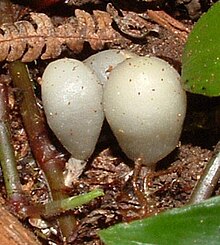Psilocybe weraroa
| Psilocybe weraroa | |
|---|---|

| |
| Scientific classification | |
| Kingdom: | Fungi |
| Division: | Basidiomycota |
| Class: | Agaricomycetes |
| Order: | Agaricales |
| Family: | Hymenogastraceae |
| Genus: | Psilocybe |
| Species: | P. weraroa
|
| Binomial name | |
| Psilocybe weraroa Borovička, Oborník & Noordel. (2011)
| |
| Synonyms[1] | |
|
Secotium novae-zelandiae G.Cunn. (1924) | |
| Psilocybe weraroa | |
|---|---|
| gills on hymenium | |
| cap is conical or ovate | |
| hymenium attachment is irregular or not applicable | |
| stipe is bare or lacks a stipe | |
| spore print is purple-brown | |
| ecology is saprotrophic | |
| edibility: psychoactive | |
Psilocybe weraroa (syn. Weraroa novae-zelandiae), is a hallucinogenic pouch fungus of New Zealand.
Taxonomy[]
The species was first described in the literature in 1924 by the New Zealand-based mycologist Gordon Heriot Cunningham, under the name Secotium novae-zelandiae.[2] Rolf Singer transferred it to Weraroa in 1958.[3] Phylogenetic analysis by Moncalvo (2002)[4] and Bridge et al. (2008)[5] has demonstrated the close relationship between Weraroa novae-zelandiae and the hallucinogenic blue-staining group of Psilocybe, particularly Psilocybe subaeruginosa. Phylogenetic analysis published by Borovička and colleagues (2011) shows this species is very close to Psilocybe cyanescens. Given this and the apparently distant relation with other species of Weraroa Borovička et al. (2011) suggest renaming the species Psilocybe weraroa.[6] The specific epithet weraroa refers to the former generic name. The binomial could not be used, as it had already been used in 1978 by Gastón Guzmán and Egon Horak for another Psilocybe species.[7][8]
Description[]
- Peridium: (1)3–5 cm tall, 1.5– 3 cm wide, irregularly roundish to ovate, elliptical or even depressed-globose, margin folded, light brown when young becoming pale blue-grey, often showing blue or blue-green stains with age, at first finely fibrillose becoming smooth, glabrous, slightly viscid, bruising blue when injured, slowly. Drying dingy brown.
- Gleba: Chocolate or sepia-brown, sparse, chambered, contorted gill-like structures.
- Spores: 11–15(17) x 5–8 µm in size, smooth, sepia-coloured, elliptic-ovate or elliptical in shape, rounded at one end with a thin epispore.
- Stipe: Up to 4 cm tall, 6 mm thick, equal, cartilaginous, whitish to blue-grey, yellowish-brown at the base, hollow, bruising blue when injured.
- Taste: Bitter-sweet, earthy flavor, released upon chewing of the raw fruit, probably not a taste sought after for culinary purposes.
- Odor: Organic, similar to ferns, undertone of rubber.
- Microscopic features: Oval spores
is often mistaken for P. weraroa since they are both naturally pale bluish, however, unlike P. weraroa, W. virescens does not stain blue. The sepia color of the gleba also serves to separate P. weraroa from similar species in the genus Weraroa.[citation needed]
Habitat and distribution[]
Psilocybe weraroa is found growing solitary to gregarious on decaying wood buried in forest leaf litter, often on the rotting branches of Melicytus ramiflorus. It has also been found fruiting on rotted cabbage trees and is often associated with decaying fern fronds, native to the forests of New Zealand. Found countrywide this species is most commonly found in the North Island, with the Wellington Region being particularly abundant. The mushroom is sometimes hard to see because it is usually hidden under dried leaves. It is often eaten by slugs and sometimes hard to find specimens that haven't been nibbled on.[citation needed]
Psychoactivity[]
Psilocybe weraroa is psychoactive. Psilocin and psilocybin are the chemical components considered to be responsible for its effects, as with other blue-staining fungi of the genus Psilocybe.


References[]
- ^ "Psilocybe weraroa Borovička, Oborník & Noordel. 2011". MycoBank. International Mycological Association. Retrieved 2011-07-22.
- ^ Cunningham GH (1924). "A critical revision of the Australian and New Zealand species of the genus Secotium". Proceedings of the Linnean Society of New South Wales. 49 (2): 97–119.
- ^ Singer R. (1958). "New genera of fungi, IX. The probable ancestor of the Strophariaceae: Weraroa gen. nov". Lloydia. 21: 45–7.
- ^ Moncalvo JM, Vilgalys R, Redhead SA, Johnson JE, James TY, Catherine Aime M, Hofstetter V, Verduin SJ, Larsson E, Baroni TJ, Greg Thorn R, Jacobsson S, Clémençon H, Miller OK (2002). "One hundred and seventeen clades of euagarics". Molecular Phylogenetics and Evolution. 23 (3): 357–400. doi:10.1016/S1055-7903(02)00027-1. PMID 12099793.
- ^ Bridge PD, Spooner BM, Beever RE, Park D-C (2008). "Taxonomy of the fungus commonly known as Stropharia aurantiacea, with new combinations inLeratiomyces". Mycotaxon. 103: 109–21.
- ^ Borovička J, Noordeloos ME, Gryndler M, Oborník M (2011). "Molecular phylogeny of Psilocybe cyanescens complex in Europe, with reference to the position of the secotioid Weraoa novae-zelandiae" (PDF). Mycological Progress. 10 (2): 149–55. doi:10.1007/s11557-010-0684-3.
- ^ Guzmán G, Horak E (1978). "New species of Psilocybe from Papua New Guinea, New Caledonia and New Zealand" (PDF). Sydowia. 31 (1–6): 44–54.
- ^ Redhead SA, Moncalvo J-M, Vilgalys R, Matheny PB, Guzmán-Dávalos L, Guzmán G (2007). "(1757) Proposal to conserve the name Psilocybe (Basidiomycota) with a conserved type" (PDF). Taxon. 56 (1): 255–7. JSTOR 25065762.
External links[]
 Media related to Psilocybe weraroa at Wikimedia Commons
Media related to Psilocybe weraroa at Wikimedia Commons- “Hey Man, Do they grow any Weraroa around here?” by Peter Werner
- Manaaki Whenhua Landcare Research
- Mycotopia
- Entheogens
- Psychoactive fungi
- Psilocybe
- Psychedelic tryptamine carriers
- Fungi described in 1924
- Fungi of New Zealand
- Secotioid fungi